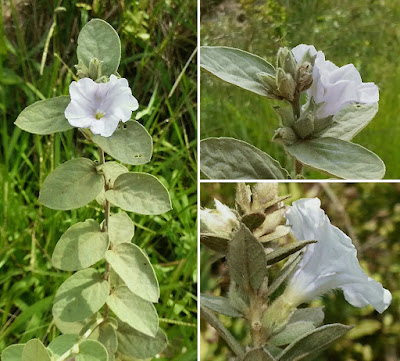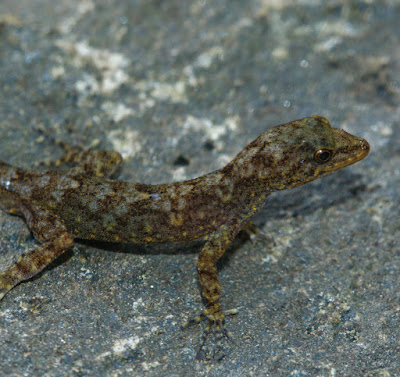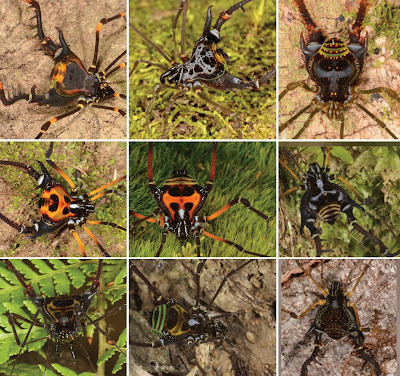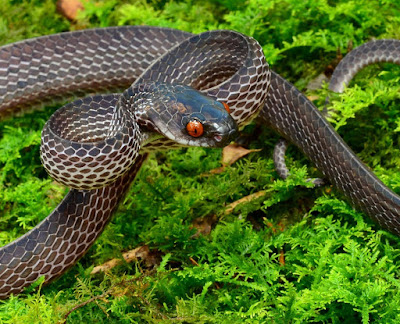[Most Recent Entries] [Calendar View]
Wednesday, March 24th, 2021
| Time | Event | ||||||
| 3:18a | [Botany • 2021] Bonamia eustachioi (Convolvulaceae) • A New Species from the Brazilian Cerrado and Caatinga
Abstract: Bonamia eustachioi is here described as a new species of Convolvulaceae from the states of Bahia and Minas Gerais, Brazil, where it grows in Caatinga and Cerrado vegetation. It is described, illustrated, and compared to similar species. Keywords: Brazilian savanna, conservation, Solanales, taxonomy
Bonamia eustachioi A. L. C.Moreira & Kojima, sp. nov. Etymology.— This species is named after the collector Jair Eustáquio Quintino de Faria Júnior, taxonomist and specialist in the flora of the Cerrado. He is one of the younger generation of Brazilian botanists, who has an outstanding eye for new plant species.
André Luiz da Costa Moreira, Roberta Keyla Kojima, Rosangela Simão-Bianchini and Taciana Barbosa Cavalcanti. 2021. Bonamia eustachioi (Convolvulaceae), A New Species from the Brazilian Cerrado and Caatinga. Brittonia. DOI: 10.1007/s12228-021-09662-z | ||||||
| 3:49a | [Herpetology • 2021] Cnemaspis rajgadensis • Dwarfs of the fortress: A New Cryptic Species of Dwarf Gecko of the Genus Cnemaspis Strauch, 1887 (Squamata, Gekkonidae) from Rajgad Fort in the northern Western Ghats of Maharashtra, India
Abstract A new species of the genus Cnemaspis Strauch, 1887 is described from the Rajgad fort in the northern Western Ghats of Maharashtra, India. The new species, belonging to the flaviventralis clade, is one of the smallest known Indian Cnemaspis and can be distinguished from other congeners by its genetic distinctiveness and few key morphological characters. The new species can be diagnosed from all other Indian congeners by its small body size (SVL < 27 mm), the absence of conical and spine-like tubercles on flank; heterogeneous dorsal pholidosis; presence of only femoral pores and no precloacal pores in males; weakly keeled scales on the ventral surface of neck, pectoral, abdominal region and limbs; granular scales on the tail with whorls of slightly enlarged, strongly keeled tubercles; and the absence of enlarged median subcaudal scales. The new species is currently known to inhabit the man-made historical structures from a single locality in Rajgad, Maharashtra, where it is presumed to be uncommon. Key Words: Cnemaspis rajgadensis sp. nov., taxonomy, dwarf gecko, cryptic species, reptiles, forts of Maharashtra
Cnemaspis rajgadensis sp. nov. Diagnosis: A small-sized Cnemaspis with adult SVL < 27 mm,; 7–7 supralabials; 6–7 infralabials; dorsal scales heterogeneous with small, granular, weakly keeled scales, intermixed with randomly arranged, weakly keeled, slightly larger tubercles; conical and spine-like tubercles absent on either side of the flanks but a row of enlarged tubercles present on the lower flanks; dorsal paravertebral scales 80–92; mid-dorsal scales 62–67; ventral surface of neck, pectoral, abdominal region, under limbs, and tail weakly keeled; mid-ventral scales 123–141; ventral scales across mid-body 28–29; subdigital lamellae under fourth digit of manus 15, under fourth digit of pes 18; males with 3 femoral pores and absence of precloacal pores; dorsal scales of tail granular, weakly keeled, roughly same in size and shape to those on mid-body dorsum, gradually becoming larger, flattened, blunt, sub-imbricate posteriorly, intermixed with whorls of slightly enlarged, strongly keeled tubercles; scales on ventral aspect of original tail imbricate, weakly keeled, without a series of enlarged sub-caudal scales, roughly same in size of those on dorsal tail; a single enlarged postcloacal spur on each side.
Etymology: The species epithet is derived from the Rajgad fort of Pune District, Maharashtra, India, from where the type series was collected. Rajgad is a hill fort and historical place, which was the capital of the Maratha Empire under the rule of Chhatrapati Shivaji Maharaj for almost 26 years during the 17th century. Previously known as Murumdev, Rajgad fort is located around 60 km to the south-west of Pune and about 15 km west of Nasrapur village in the range of northern Western Ghats. Suggested common name: Rajgad Dwarf Gecko Distribution: Currently, Cnemaspis rajgadensis sp. nov., is known from only its type locality – Rajgad fort, Pune District, Maharashtra. Amit Sayyed, Vivek Philip Cyriac, Anish Pardeshi and Shauri Sulakhe. 2021. Dwarfs of the fortress: A New Cryptic Species of Dwarf Gecko of the Genus Cnemaspis Strauch, 1887 (Squamata, Gekkonidae) from Rajgad Fort in the northern Western Ghats of Maharashtra, India. Evolutionary Systematics. 5(1): 25-38. DOI: 10.3897/evolsyst.5.62929 | ||||||
| 1:04p | [Arachnida • 2021] Revision of the southern Andean Genus Sadocus Sørensen, 1886 (Opiliones, Gonyleptidae, Pachylinae) Abstract Species of the genus Sadocus Sørensen, 1886 are conspicuous gonyleptids that occur in Chile and Argentina. Here, the genus is revised for the first time and the cladistic analysis based on morphological characters does not corroborate its monophyly unless a phylogenetically unrelated species is excluded (explained further on). A new classification is proposed for the seven species left in the genus and considered valid, of the 13 nominal species previously recognized. Two out of the seven valid species are considered as species inquirendae: Sadocus allermayeri (Mello-Leitão, 1945) [= Carampangue allermayeri Mello-Leitão, 1945] and Sadocus nigronotatus (Mello-Leitão, 1943) [= Carampangue nigronotatum Mello-Leitão, 1943]. The following synonymies are proposed: Sadocus bicornis (Gervais, 1849) [original combination = Gonyleptes bicornis Gervais, 1849] is a junior synonym of Sadocus asperatus (Gervais, 1847) [= Gonyleptes asperatus Gervais, 1847]; Sadocus conspicillatus Roewer, 1913, Sadocus exceptionalis (Mello-Leitão, 1946) [= Araucanoleptes exceptionalis Mello-Leitão, 1946] and Sadocus guttatus Sørensen, 1902 are junior synonyms of the valid name Sadocus polyacanthus (Gervais, 1847) [= Gonyleptes polyacanthus Gervais, 1847]; and Sadocus calcar (Roewer, 1913) [= Lycomedes calcar Roewer, 1913] is a junior synonym of the valid name Gonyleptes horridus Kirby, 1819. Sadocus brasiliensis Soares & Soares, 1949 is not congeneric with Argentinean/Chilean species of the genus according to the cladistic analysis and is here synonymized with Discocyrtus catharinensis (Mello-Leitão, 1923 [= Sadocus catharinensis Mello-Leitão, 1923]). Keywords: Argentina, Chile, harvestmen
Marília Pessoa-Silva, Marcos Ryotaro Hara and Ricardo Pinto-da-Rocha. 2021. Revision of the southern Andean Genus Sadocus Sørensen, 1886 (Opiliones, Gonyleptidae, Pachylinae). ZooKeys. 1025: 91-137. DOI: 10.3897/zookeys.1025.57806 | ||||||
| 1:10p | [Mammalogy • 2021] Walking on Water: the Unexpected Evolution of Arboreal Lifestyle in A Large Top Predator in the Amazon Flooded Forests
Large felids (>30 kg) have exclusively carnivorous diets and depend upon medium and large terrestrial prey to fuel high metabolic demands (Sunquist and Sunquist 2002, Carbone et al. 2007). Although some of them commonly use trees for resting, hunting, avoiding predators or competitors (e.g., leopards Panthera pardus [Le Roux and Skinner 1989] and pumas Puma concolor [Santos et al. 2014]), and others may prey on arboreal, aquatic, and semiaquatic species (e.g., jaguars Panthera onca [Azevedo and Verdade 2012] and tigers Panthera tigris [Mukherjee and Sen Sarkar 2013]), there are no documented cases of large felids living a primarily arboreal existence for extended periods. Here, we report the evolution of a unique lifestyle for a large terrestrial top predator, in which jaguars live an arboreal and semiaquatic existence for 3–4 months of the year in a completely flooded environment during the annual high‐water season of the Amazon River Basin (Fig. 1). ... Emiliano E. Ramalho, Martin B. Main, Guilherme C. Alvarenga and Luiz Gustavo R. Oliveira‐Santos. 2021. Walking on Water: the Unexpected Evolution of Arboreal Lifestyle in A Large Top Predator in the Amazon Flooded Forests. Ecology. DOI: 10.1002/ecy.3286 | ||||||
| 1:19p | [Herpetology • 2021] Corythomantis botoque • There and Back Again from Monotypy: A New Species of the Casque-Headed Corythomantis Boulenger 1896 (Anura, Hylidae) from the Espinhaço Mountain Range, Brazil
Abstract The genus Corythomantis was monotypic for over 100 yr, encompassing only the species C. greeningi. In 2012, a second species, C. galeata, was described, but this species was recently reassigned to Nyctimantis, rendering Corythomantis once again monotypic. The geographic distribution of C. greeningi covers the Caatinga and Cerrado biomes from northeast Brazil, with a western limit in Tocantins state and a southern limit in Minas Gerais state. Here we demonstrate the existence of a second species of Corythomantis through molecular, acoustic, and morphological data. The new species differs in morphology from C. greeningi in head shape and tibia coloration. The new species has an advertisement call with shorter duration, higher pulse rate, and different acoustic structure. Mitochondrial deoxyribonucleic acid (DNA) data show a genetic divergence from C. greeningi of 2.88% in the 16S ribosomal DNA gene and 14.06% in the cytochrome oxidase I gene. The geographic distribution of the new species is restricted to the Espinhaço Mountain Range at elevations from 315 to 930 m above sea level. KEYWORDS: Bahia state, Corythomantis botoque, Endemism center, larval morphology, Lophyohylini, Minas Gerais state Ricardo Marques, Célio F. B. Haddad and Adrian A. Garda. 2021. There and Back Again from Monotypy: A New Species of the Casque-Headed Corythomantis Boulenger 1896 (Anura, Hylidae) from the Espinhaço Mountain Range, Brazil. Herpetologica. 77(1); 56-71. DOI: 10.1655/0018-0831-77.1.56 | ||||||
| 1:22p | [Herpetology • 2021] Asthenodipsas ingeri • On the Taxonomic Status of Asthenodipsas vertebralis (Boulenger, 1900) (Squamata: Pareidae) in Borneo with the Description of A New Species from Mount Kinabalu, Sabah Abstract The taxonomic status of Asthenodipsas vertebralis in Borneo has been plagued with uncertainty over the last eighty years. An examination of museum collections resulted in the discovery of a voucher specimen of A. vertebralis from Sarawak, East Malaysia that confirms the presence of the species in Borneo and a previously unrecognised species, Asthenodipsas ingeri sp. nov. from Mount Kinabalu, Sabah. Asthenodipsas ingeri sp. nov. can be differentiated from its congeners by the combination of an absence of preoculars and suboculars, 1st and 3rd pair of infralabials in contact, two pairs of posterior inframaxillaries, supralabials 3–5 (sometimes 3 & 4) in contact with orbit, 15/15/15 rows of dorsal scales, presence of sharp vertebral keel, and divided subcaudals. This study highlights the importance of careful re-examination of museum collections that could potentially harbour new species hiding in plain sight. These discoveries also add to the growing number of reptile and amphibian species being described from Borneo that shows no signs of abating but are already potentially threatened by the continued deforestation and developments on the island. Keywords: Reptilia, Pareas, Sundaland, slug snake, systematics, discovery, reptile, conservation, endemic biodiversity, Malaysia Asthenodipsas ingeri sp. nov. Evan S. H. Quah, Kelvin K. P. Lim and L. Lee Grismer. 2021. On the Taxonomic Status of Asthenodipsas vertebralis (Boulenger, 1900) (Squamata: Pareidae) in Borneo with the Description of A New Species. Zootaxa. 4949(1); 24–44. DOI: 10.11646/zootaxa.4949.1.2 |
| << Previous Day |
2021/03/24 [Calendar] |
Next Day >> |























